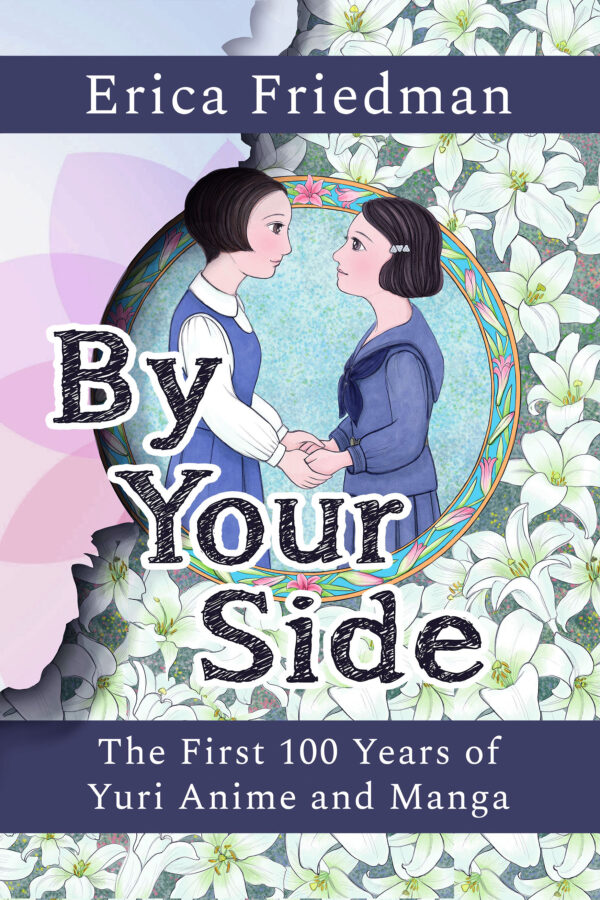by

The Untold Story of Lesbian Love in Japanese Anime and Comics
Two decades in the making, By Your Side is a collection of essays, scholarly and approachable, by the Western Hemisphere’s authority on the subject. This landmark work should be in the library of any fan of anime, manga, lesbian relationships in media–or any combination of the three!
--
“By Your Side is the complete Yuri resource I only ever dreamed could exist…Friedman graces readers with illuminating insights as they follow her through a century of the genre’s evolution and revolution.”
Nicki Bauman, Yurimother
--
“The first in-depth study of Yuri in English.”
James Welker, Professor of Cross-Cultural and
Japanese Studies, Kanagawa University
Whether you call it yuri or GL, the genre of women loving women in anime and manga hasn't always been understood or appreciated. Erica Friedman's new book By Your Side: The First 100 Years of Yuri Anime and Manga is a major step in the right direction towards changing that. The book is a thoughtful, readable look at the history of the genre, examining its roots in the works of early twentieth century authors like Yoshiya Nobuko, whose Hana Monogatari established many of the tropes that still remain in use, and moving forward through time to how series like Sweet Blue Flowers and I'm in Love with the Villainess continue to grow yuri tales and keep them relevant to readers today. While there is a degree of repetition, the book is a must-read for genre enthusiasts or those simply interested in explorations of queer fiction.
Among the topics covered in the text, a particularly interesting one is a discussion of what we actually call stories about lesbians. Friedman tells us that “yuri” comes from a special page in a magazine for gay men, where lesbians were referred to as the “lily tribe” (yurizoku). As terminology has evolved and changed within homoerotic content and stories about queer men have been grouped under the heading of “BL,” there's been a publisher-driven push to call stories about queer women “GL” as an equivalent term. Throughout the book, Friedman works to establish a firm definition of yuri that is perhaps only tangentially related to what we call it, because the more important thing is to enjoy it, no matter your own gender or sexual orientation. The idea that yuri is for everyone (and I will continue to use “yuri” in this review, as that's primarily what Friedman uses) is one of the most important ideas readers can take from the text, and one the author explores as she goes through the various anthologies' target audiences.
Stories of girls falling in love originate with Yoshiya Nobuko's stories from the 1920s, of which only one is available in English translation as of this writing. (Yellow Rose is available as an ebook and is very much worth reading.) Her works are the originators of what we today know as “Class S” stories – romances set in a girls' school named after a dubious Catholic saint, often involving some sort of big/little sister system. Friedman's clear explanation of this subgenre of yuri is excellent for better understanding both the roots and nuances of Class S series, and as may be expected, an entire chapter is dedicated to Maria Watches Over Us, deconstructing and analyzing the girls of the series and the way that their relationships inform and shape our understanding of it. There is frequent comparison of this title with Strawberry Panic!'s parodic use of Class S tropes, and if nothing else, the discussion of both makes you want to revisit both stories, armed with Friedman's analysis.
Another especially strong element of the text is the historical context in terms of the publication of yuri series in both English and Japanese. It's plain to see that we lack many of the foundational series in English translation, which likely hampers the average reader's dive into a full appreciation of the genre, and By Your Side is very helpful in that sense. While it would have been interesting to see a fuller discussion of the differences between stories written for women and those written with a distinctly male gaze in mind (a topic which is touched on, but not expanded upon), the acknowledgment that these are often two very different sorts of works is a positive. It also informs the discussions of Sailor Moon S and Revolutionary Girl Utena, two important mainstream series with heavy lesbian themes and openly queer characters that helped many fans to find the genre in the first place. While the attempt to rebrand Haruka and Michiru as “cousins” is barely touched upon – it deserves an essay in a different context about queer erasure, which isn't covered in this work – the importance of their relationship and the way that they raise Hotaru with Setsuna at the end of their initial storyline is given its due in terms of showing the importance of a family with two (or three) mothers as functional and loving.
Most of the essays in the book were originally published in other venues, and that does contribute to the repetition of concepts and content. Rather than being a detriment, however, I believe that it serves as an aid to understanding key points and how Friedman's own writing and analysis has grown and changed over time as the genre has. As the youngest of the niche genres (in terms of gaining official recognition in the publishing industry), and one based in a subculture that still isn't completely accepted either in the U.S. or Japan, it's natural that depictions and elements of both it and our analysis of it would evolve over time, and the republication (with editing, of course) of Friedman's earlier works does allow us to appreciate that, as well as to zero in on key concepts.
If you are a fan of yuri or simply want to understand what the deal is with any of the genre's elements or major texts, I'd highly recommend reading this book. It's both an analysis of and a love letter to the genre, both academic and accessibly readable, and worth your time.






